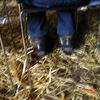9.6.2008 | 07:27
Hungur heimsins ..........
Ég er þakklát fyrir það sem ég á, sérstaklega þegar ég pakksödd með fullan ískap af mat sem eyðileggst oft á tíðum vegna ofgnóttar hér á bæ.
Rakst á þetta:
Hunger in the U.S.
Families in Crisis
It is a tragic reality that the United States, one of the richest nations in the world, is also plagued with a poverty-driven hunger crisis. The statistics tell the troubling story. In 2005:
- 37 million people (12.6%) were in poverty
- 12.9 million (17.8%) children under the age of 18 were in poverty
- 20.5 million (11.3%) of people aged 18-64 were in poverty
- 3.6 million (10.1%) seniors 65 and older were in poverty, an increase from 3.5 million in 20041
Poverty is forcing millions of Americans into a hunger crisis. Their hunger emergency is defined by food insecurity, which is the lack of access to sufficient, safe and nutritious food to meet their dietary needs for an active and healthy life.2 Families find themselves buying cheaper and less nutritious food, or cutting entire meals out of their diet, just to make ends meet. Increasing over time, this pattern leads to chronic malnutrition, affecting children and families in profoundly destructive ways.
"[Hunger] weakens families, and prevents our nation from reaching its full potential."3 Hungry children are not able to play and learn like other children, and are therefore less likely to become productive adults. Compromised health can lead to both short- and long-term problems; children and the elderly are particularly vulnerable. Hungry employees are less productive and more likely to make errors, putting their job at risk, which further perpetuates the poverty cycle.
Both the commonplace demands of daily life and unexpected, dramatic events can easily push families below the poverty line. "Families are often forced to make the tradeoff between food and other expenses. Health care is a particular problem. In poor, rural communities families often have no choice but to use the emergency room for routine health care. This is very expensive. Car repairs are another significant and unexpected expense. If the family car needs repair and it is the end of the month, when cash reserves are low, a family will have no choice but to reduce food intake to get the car back on the road in order to go to work."4
The Hidden Poor
Food insecurity affects many segments of the American population, including:
Children: According to the USDA, an estimated 12.4 million children lived in food-insecure households in 2005.5
Seniors: 6% of households with seniors (1.6 million households) were food insecure (low food security and very low food security).5 A study that examined the health and nutritional status of seniors found that food-insecure seniors had significantly lower intakes of vital nutrients in their diets when compared to their food-secure counterparts. In addition, food-insecure seniors were 2.33 times more likely to report fair/poor health status and had higher nutritional risk.6
Working Poor: In 2002, over 4 million non-elderly, low-income families reported using a food pantry in the past 12 months. 7 In 2002, nearly 2 million working parents with children turned to food pantries.7
Rural Poor: 16.6% of all rural households with children are food insecure (low food security and very low food security), an estimated 1 million children.5
Ég veit ekki alveg hvað ég get gert umfram það sem ég legg til hér og þar til hjálpar þeim sem þurfa.
Njótum dagsins lífsins og hvers annars.

 arabina
arabina
 bergdisr
bergdisr
 kiddijoi
kiddijoi
 molinn
molinn
 nimbus
nimbus
 psi
psi
 fugla
fugla
 vefritid
vefritid










Bæta við athugasemd [Innskráning]
Ekki er lengur hægt að skrifa athugasemdir við færsluna, þar sem tímamörk á athugasemdir eru liðin.